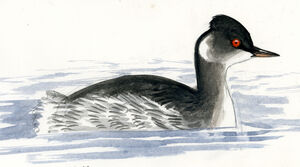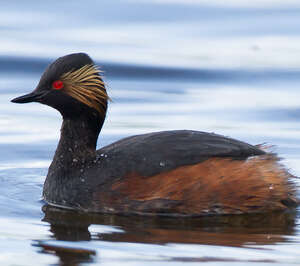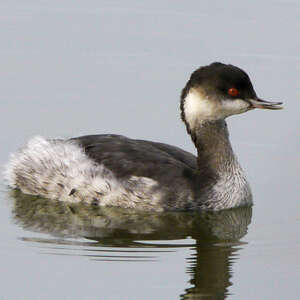Black-necked Grebe
Podiceps nigricollis - Grèbe à cou noir
Identification
The Black-necked Grebe is a small grebe, about the same size as the Slavonian Grebe with which it can be confused in winter plumage.
The breeding adult is easily identifiable by its plumage. The head, neck, chest and upper parts are black while the flanks are a bright chestnut brown (the Slavonian breeding adult has chestnut brown neck as well as flanks). The head is remarkable with the black crown plumes and especially the elongated blonde plumes behind the bright red eye. The black beak has a straight culmen and a convex gonys, giving it an upturned look, accentuated if necessary by the mobility of the ramphotheques (see photos).
In the winter, the adult loses its beautiful colours. It is grey, black and white. It is the head that must be looked at closely. The black of the crown, curved in the middle, descends under the red eye and there is a slight grey gradient with the throat, lower cheeks and neck white. The beak is identical. In the winter, the Slavonian has no curved crown and the black/white line under the eye is distinct. But above all the beak is different. The culmen and gonys are convex and give a straight beak and the tip of the beak is white.
In the juvenile, the black upper parts are marked with brown and the lower parts are whitish with the front of the neck greyish. There is no clear boundary on the sides of the head. The eye is brownish reddish. The beak is yellowish and somewhat upturned. The first winter bird has the eye still dull reddish, the front of the neck less dark and the upper parts less obviously black than the adult. The Slavonian in the same conditions is more contrasted, more black and white, but it is the beak that makes the diagnosis. This means that the birds must not be too far apart.
Subspecific information 3 subspecies
- Podiceps nigricollis nigricollis (Eurasia)
- Podiceps nigricollis gurneyi (Africa south of the Sahara)
- Podiceps nigricollis californicus (North America)
Foreign names
- Grèbe à cou noir,
- Zampullín cuellinegro,
- cagarraz,
- Schwarzhalstaucher,
- feketenyakú vöcsök,
- Geoorde Fuut,
- Svasso piccolo,
- svarthalsad dopping,
- Svarthalsdykker,
- potápka čiernokrká,
- potápka černokrká,
- Sorthalset Lappedykker,
- mustakaulauikku,
- Swartnekdobbertjie (Swartnekduikertjie),
- cabussó collnegre,
- Stargoði,
- (perkoz) zausznik,
- melnkakla dūkuris,
- črnovrati ponirek,
- Черношейная поганка,
- ハジロカイツブリ,
- 黑颈䴙䴘,
- นกเป็ดผีคอดำ,
- 黑頸鸊鷈,
Voice song and call
Habitat
The Black-necked Grebe nests on water bodies surrounded by vegetation growing in the water (phragmites, scirpes, reeds, bulrushes, .
In the winter months, the birds change their habitat and frequent salt water. They often gather in large numbers on coastal waters, in bays and around islands, and also in large saline lakes in the interior, such as the Burdur G?l? in Turkey. The salt marshes are also occupied due to their abundance of lower crustaceans.
Behaviour character trait
In the wintertime, the Black-necked Grebe is particularly gregarious. It can form groups of several thousand individuals or more.
For instance, Lake Burdur has already hosted more than 180,000 of them. In France, migrating individuals from the north come to reinforce the winter numbers, reaching several thousands. The Etang de Berre is a good site for them.The Black-necked Grebe is colonial for reproduction. In Europe, it often settles in colonies of Common Gulls or Moustached Warbler. This behaviour offers it additional safety for its nests.
Flight
Dietfeeding habits
The Black-necked Grebe mainly consumes aquatic macro-invertebrates, insects and their larvae, small crustaceans such as Artemia, and to a lesser degree, small aquatic vertebrates and their larvae. Depending on the available prey, it can hunt between two waters or on the bottom, pecking animals with its beak.
Reproduction nesting
The Black-necked Grebe is monogamous and colonial. In Europe, the colonies are usually small, but elsewhere in the world they can include several hundred nests. Breeding season for birds in the Northern Hemisphere is generally from April to August with some variations depending on the latitude. In South Africa it is from October to April. There is only one breeding each year.
The pairing usually takes place upon arrival at the breeding grounds. It involves audible displays as the adults face each other, with their head alternating, rearranging their dorsal plumage, standing vertically in front of each other, raising their crown and displaying their ornamental feathers, and swimming side by side with their feet paddling against the surface.
The nest is built in shallow, emergent, or submerged vegetation, on dead plant rafts, or on living or dead macrophytes. It is made of dead or living vegetation collected from the surrounding area and piled together. The couple will continue to feed the nest during the entire breeding period to keep the eggs out of the water. The nest, on average, has a diameter of 26 cm.
The female lays 2 to 4 white-bluish, sub-elliptical eggs that become brown with time. Both the male and female incubate the eggs for about 3 weeks. The chicks are nidifugous - during the first weeks they are carried by their parents on their back, as is common among the grebes. During the first week, when their parent dives, the chicks stay under the adult's wings. At 10 days, they begin diving and climbing onto the adults' backs less often. Following that, each adult takes care of part of the brood for additional weeks.
The major French nesting populations are in regions with plentiful ponds: Forez, Dombes, Brenne, Sologne, Camargue, region of Mosellan ponds.
Geographic range
The Black-necked Grebe has a vast global distribution. It is present on all 4 continents. Its breeding and wintering areas are almost completely separate. The nominate subspecies breeds in Western Europe to Central Siberia, then a little in Mongolia, and finally in Northeast China. It winters to the south and west, on the coasts of the Netherlands to Morocco, around the Mediterranean, in Western Asia (coasts and inland waters), occasionally in Southwest Asia, and on the Chinese and Japanese coasts.
The subspecies gurneyi breeds occasionally in East Africa (Ethiopia and Tanzania) and especially in the south of the continent in Namibia and South Africa. It is resident.
Finally, the subspecies californicus breeds from southwestern Canada to the center of Mexico, passing through the west of the United States. It winters on the Pacific coast of the southwest of Canada to Guatemala, as well as on the large inland waters.
Threats - protection
IUCN conservation status
concern
in the Wild
threatened
evaluated
This rare species (Black-necked Grebe) is non threatened in France (population amounting to about 1,200 mating pairs). Its status in Europe is also non-threatened, with its populations doing well and increasing. Maintaining the quality of aquatic habitats is essential for its conservation. The wintering populations in the sea are regularly victims of hydrocarbons (oil spills and vapor releases).
Sources of information
- IOC World Bird List (v15.1), Gill, F and D Donsker (Eds). 2025-12-07.
- Avibase, Lepage Denis
- Birds of the World, The Cornell Lab of Ornithology
- xeno-canto, Sharing bird sounds from around the world,
Other sources of interest
 Specification sheet created on
03/07/2023 by Jean François
Specification sheet created on
03/07/2023 by Jean FrançoisTranslation by AI Oiseaux.net
© 1996-2026 Oiseaux.net
- Accipitriformes
- Aegotheliformes
- Anseriformes
- Apodiformes
- Apterygiformes
- Bucerotiformes
- Caprimulgiformes
- Cariamiformes
- Casuariiformes
- Charadriiformes
- Ciconiiformes
- Coliiformes
- Columbiformes
- Coraciiformes
- Cuculiformes
- Eurypygiformes
- Falconiformes
- Galliformes
- Gaviiformes
- Gruiformes
- Leptosomiformes
- Mesitornithiformes
- Musophagiformes
- Nyctibiiformes
- Opisthocomiformes
- Otidiformes
- Passeriformes
- Pelecaniformes
- Phaethontiformes
- Phoenicopteriformes
- Piciformes
- Podargiformes
- Podicipediformes
- Procellariiformes
- Psittaciformes
- Pterocliformes
- Rheiformes
- Sphenisciformes
- Steatornithiformes
- Strigiformes
- Struthioniformes
- Suliformes
- Tinamiformes
- Trogoniformes
































